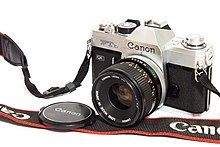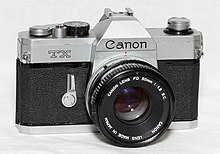Canon FT
The Canon FT QL was a 35mm SLR camera for the Canon FL bayonet , the modified version Canon FTb for the Canon FD bayonet . There were simplified versions of both cameras, the counterpart to the FT was called Canon TL , the counterpart to the FTb was first Canon TLb , then Canon TX .
FT QL
Period and classification
The Canon FT QL appeared in March 1966 and was replaced by the FTb with the appearance of the FD bayonet.
The FT-QL was essentially a Canon Pellix with an ordinary oscillating mirror. The Pellix also received the innovations, the Quickload system and the connection for the booster with the transition to the Pellix QL.
casing
The FT belongs to the cameras of the F series and is based on the aluminum housing of the Canon FX , similar to the Pellix .
Viewfinder
The built-in prism viewfinder had a ground glass with a micro prism ring .
Exposure metering
The Canon FT had a selective measurement similar to the Pellix . For this purpose, there was an inclined, partially transparent mirror in the field lens - this lens was located above the ground glass in the viewfinder. The mirror directed the light beams to a Cds sensor located at the rear in the direction of the camera. The decoupled area measured 8 mm × 12 mm as with the Pellix, this corresponded to approx. 12% of the image area and in the case of a normal lens attached, a diagonal measurement angle of approx. 15 ° resulted. Due to the reflection, the measuring area in the viewfinder was marked as a slightly darker area.
The film speed could be set on the shutter speed dial between ISO 25/15 ° and ISO 2000/34 °. The measuring range for ISO 100/21 ° was from 1 ⁄ 4 s at f / 1.2 to 1 ⁄ 1000 s at f / 16.
Canon Booster
Just like the Pellix QL, the Canon Booster could also be connected to the FT QL. However, the letter F for FT instead of P for Pellix had to be in a window of his shutter speed dial, as there was no loss of light through the partially transparent mirror. For the same reason, the time was not allowed to be set for 60 s and the measuring range deviated. At ISO 100/21 ° and f / 1.2, this ranged from 1 ⁄ 4 s to 15 s.
Clasp
Since the FT, unlike the Pellix, did not rely on a metal lock due to its oscillating mirror, it retained the horizontally running cloth lock known from the FX, the time wheel of which can be set to B / T, from 1 s to 1 ⁄ 1000 s and to " X ”for flash synchronization.
According to the FX, the mirror could be folded up manually to the left of the bayonet with a lever facing the camera. This was also necessary before attaching the super wide angle lens .
Power supply
The FT needed a PX 625 battery for the light meter. All other functions of the camera do not require electricity. This type of battery, which contains more than 25 mg of mercury, was banned in the EU from 1992. The exposure measurement, however, was dependent on the exact 1.35 V voltage and did not work properly with a 1.5 V button cell. A correction using a different setting of the film speed was also very inaccurate because the voltage of the 1.5 V batteries constantly drops during their service life. As a solution, electronic modifications with exact voltage regulation could be used or simply a zinc-air battery , which deviates only slightly at 1.4 V and maintains a constant voltage. Zinc-air batteries can usually only be used for a week after activation, but they are very inexpensive to get when you need hearing aids.
The battery test was still quite cumbersome: you first had to set the film speed to ISO 100/21 ° and the shutter speed dial to X, then you could see a rash on the pointer of the exposure meter when the main switch was in position C, which was around the rewind crank that had to reach to an index mark.
FTb
Period
Canon introduced the FTb together with the new FD bayonet in March 1971. The camera was replaced in 1976 by the Canon AT-1 , which was also equipped with a tracking pointer , and the semi-automatic Canon AE-1 , which then made automatic exposure standard in the price range.
With 1.408 million cameras, the FTb became the most popular Canon SLR camera until the AE-1 quickly surpassed this number.
Loading the film
In the later course of production, for cost reasons, the properly functioning fast charging system and thus also the letters QL were dispensed with.
CAT auto flash
The FTb was able to work together with the CAT automatic flash. This required the Speedlite 133 D flash unit and the appropriate lens with flash coupler. Just like with the Canon F-1 and in contrast to the Canon EF , the CAT system only led to a semi-automatic control, as there was no aperture transmission from the camera to the lens.
The exposure meter had to be switched off for operation. Then the flash unit moved the pointer in the viewfinder, which is otherwise influenced by brightness and shutter speed, via the additional contacts in the hot shoe. And the pointer dependent on the set aperture value had to be adjusted. The flash unit received the distance setting from the flash coupler on the lens and also took into account the charge level of its capacitor. That is why the pointer fell after the flash and slowly rose again.
Modifications
The FTb underwent a few modifications in July 1973, the set shutter speed was reflected in the viewfinder at the bottom left and some design changes were made. The transport lever was given a plastic handle, the shutter release was made longer and the dimming lever made smaller.
TL
Period
The Canon TL supplemented the SLR range in February 1968, but it was not available on the Japanese market.
Differences to FT QL
The main differences concerned the shutter speeds, which only reached up to 1 ⁄ 500 s, the lack of a self-timer and the non-lockable mirror. At the time, these features were common in emaciated cameras. In addition, the exposure meter worked with a medium-weighted integral instead of selective metering, as a result of which there was also no rectangle for the metering area in the viewfinder. In addition, you couldn't connect a booster. The Quickload system is mostly missing, but some TLs have come into circulation with it.
TLb / TX
Period
The TLb appeared in September 1974 and was renamed TX in March 1975. The Canon AT-1 replaced it as the most affordable A-series model in 1976. In contrast to the AE-1, the AT-1 had a tracking system instead of a semi-automatic exposure control.
Differences to FTb
TLb and TX differed only in the accessory shoe, which had no electrical contact with the TLb and a normal lightning trigger contact with the TX, but without the additional contacts for the CAT system.
As with the predecessor TL, the TLb also did without 1 ⁄ 1000 s exposure time, selective metering, self-timer and mirror lock . The shutter speed was not reflected in the viewfinder.
Web links
- FT QL in the Canon Camera Museum
- TL in the Canon Camera Museum
- FTb in the Canon Camera Museum
- revised FTb in the Canon Camera Museum
- TLb in the Canon Camera Museum
- TX in the Canon Camera Museum
- FT QL
swell
- Günter Richter: The Canon reflex system . Laterna magica 1980. ISBN 3-87467-118-6
Individual evidence
- ↑ Market overview single-lens reflex cameras with internal measurement , photo magazine April 1969
- ↑ EUR-Lex - 31991L0157 - EN - EUR-Lex. Retrieved November 18, 2019 .
- ^ Canon advertisement in Color Foto, April 1977 edition








